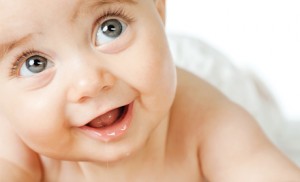Babies, toddlers and young children need help managing oral hygiene, so it’s up to parents to properly look after their kids’ teeth and gums, and to make sure to teach them how to do it — when they’re ready.
New Baby Teeth
There’s not really much to do in those first few months before your baby’s teeth start to come in, according to Richard Kennedy, DMD, of Chew Chew Junction. You can clean and massage the gums with a cold cloth he says, but that’s not really necessary. Once the teeth come in, the real work begins.
Kennedy advises using a soft, kids’ toothbrush on each emerging tooth in a gentle, circular motion. When your little one can stand, he says it may be easier to have him stand in between your legs while you sit (on the edge of the bathtub, for example). Then you can just tilt back his head for a good view and easy access.
As your baby’s teeth continue to push in, keep up with their care by using a thin smear of toothpaste for brushing, says Murray Dock, DDS of Montgomery Pediatric Dentistry. Once kids reach ages 2 – 3, parents can use a pea-sized amount of toothpaste. Dock points out that once teeth start making contact with each other, it’s time to start flossing.
Signs of Readiness
Toddlers enjoy independence and when it comes to brushing, they’ll likely try to take over the task, but parents be warned: your help is still needed. “Around age 3 kids can start to participate in brushing their teeth with parental oversight,” says Kennedy, explaining that letting kids brush their teeth helps them get used to the feel of the brush in their hands and on their teeth — practice will some day make perfect. Brush your teeth alongside your toddler for good role modeling, and then be sure to help your child finish with a little extra cleaning if need be.
Dock says that once a child can accomplish a task like tying his own shoes, he’s probably ready to take on the responsibility of his oral hygiene, but you should still continue to check that it’s getting done properly.
Are Electric Toothbrushes OK?
Both Kennedy and Dock say that electric toothbrushes can be a real motivator for kids, and suggest starting with a reasonably priced spin brush. The benefit of using a spin brush at an early age, Kennedy says, is that kids get used to the feel of what a dentist uses at the office during a typical cleaning — it’s much less scary when you know what to expect. Once kids get a little older (and hopefully more responsible, around ages 8 – 10), they can graduate to a more expensive electric toothbrush. If your child prefers a manually powered brush, that’s fine, too. “It’s all about finding which one they’ll use correctly,” says Dock.
Why a Pediatric Dentist?
Pediatric dentists have additional specialty training after dental school to care for infants and children through the teenage years.
Right Time for a First Visit?
Both the American Dental Association and the American Academy of Pediatric Dentistry recommend that children have their first dental visit when their first tooth appears, and no later than their first birthday. After that, schedule check-ups every six months, as mouths grow and change quickly.





